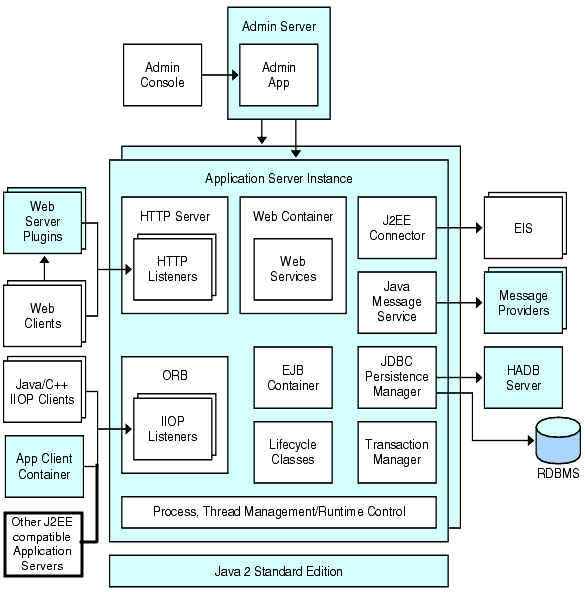Server Instance
The server instance is a single Java EE compatible Java Virtual Machine hosting an Application Server on a single node. Each server instance has a unique name in the domain. A clustered server instance is a member of a cluster and receives all of its applications, resources, and configuration from its parent cluster; ensuring that all instances in the cluster are homogeneous. An unclustered server instance does not belong to a cluster and as such has an independent set of applications, resources, and configuration. The following figure shows an application server instance in detail. The application server instance is a building block in the clustering, load balancing, and session persistence features of the Application Server.
Figure 1–2 Application Server Instance

The Sun Java System Application Server creates one application server instance, called server, at the time of installation. For many users, one application server instance meets their needs. However, depending upon your environment, you might want to create one or more additional application server instances. For example, in a development environment you can use different application server instances to test different Application Server configurations, or to compare and test different application deployments. Because you can easily add or delete an application server instance, you can use them to create temporary sandbox area for experimentation purposes.
In addition, for each application server instance, you can also create virtual servers. Within a single installed application server instance you can offer companies or individuals domain names, IP Addresses, and some administration capabilities. For the users, it is almost as if they have their own web server, without the hardware and basic server maintenance. These virtual servers do not span application server instances. For more information about virtual servers, see Chapter 13, Configuring the HTTP Service.
In operational deployments, for many purposes you can use virtual servers instead of multiple application server instances. However, if virtual servers do not meet your needs, you can also use multiple application server instances. On stopping, application server instance stops accepting new connections, then waits for all outstanding connections to complete. If your machine crashes or is taken offline, the server quits and any requests it was servicing may be lost.
Defining Application Server Instances
Application server instances form the basis of an application deployment. Each instance belongs to a single domain and has its own directory structure, configuration, and deployed applications. Each server instance also includes the Java EE platform web and EJB containers. Every new server instance must contain a reference to a node agent name defining the machine on which the instance will reside.
Note –
You cannot create Application Server instances on a developer domain. A developer domain is always associated only with the default instance, server1. To create multiple instances, you need to create a domain with the cluster profile. For information on creating domains, see the manpage for the command create-domain or consult the Admin Console Online Help.
You can create three types of server instances:
-
In the standalone server instance the configuration is not shared by any other server instance or clusters.
-
In the shared server instance the configuration is shared with other instances or clusters.
-
In the clustered server instance the configuration is shared with other instances in the cluster.
A cluster is a group of server instances sharing the same set of applications, resources, and configuration information. A server instance can belong to only one cluster. Among other things, the cluster is used to facilitate load balancing, through distribution of a load across multiple machines, and high availability, through instance level failover.
Viewing General Server Information
From the General Tab you can perform the following tasks:
-
Click Start Instance to start the instance.
-
Click Stop Instance to stop the instance.
-
Click View Log Files to open the server log viewer.
-
Click Rotate Log File to rotate the log file for the instance.
This action schedules the log file for rotation. The actual rotation takes place the next time an entry is written to the log file. The rotation happens immediately for the default server (the DAS) but is delayed for other standalone server.
-
Click JNDI Browsing to browse the JNDI tree for a running instance.
-
Click Recover Transactions to recover incomplete transactions.
In addition, you can select the following tabs to perform these additional tasks:
-
Applications Tab: deploy a selected application.
-
JVM Settings Tab: configure the JVM general settings used by the Application Server.
-
Resources Tab: manage a selected resource.
-
Properties Tab: configure instance specific properties.
-
Logging Tab: configure the logging levels used by the Application Server.
-
Monitor Tab: view monitoring data for JVM, Server, Thread Pools, HTTP Service, and Transaction Service.
-
Advanced Tab: set general properties for deploying applications.
Note –
The Start Instance option and tabs such as Rresources and Properties are not available if you are running Admin Console on a Developer Profile.
- © 2010, Oracle Corporation and/or its affiliates
